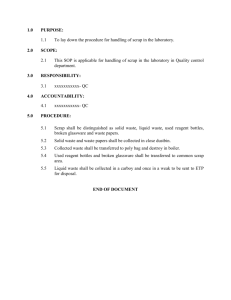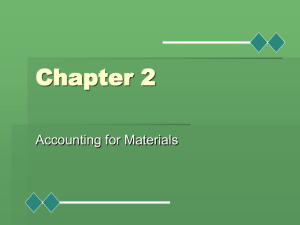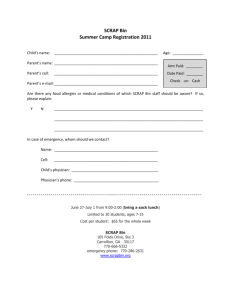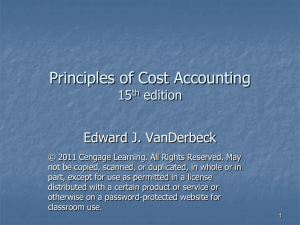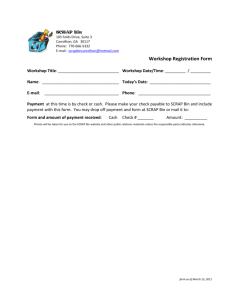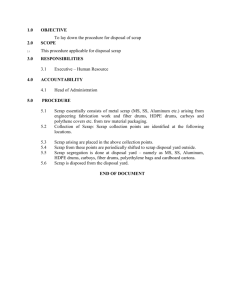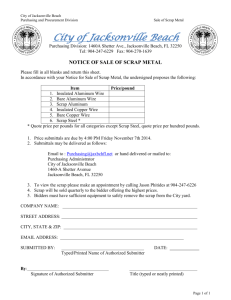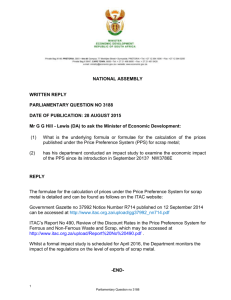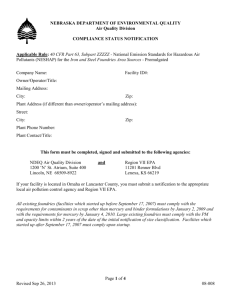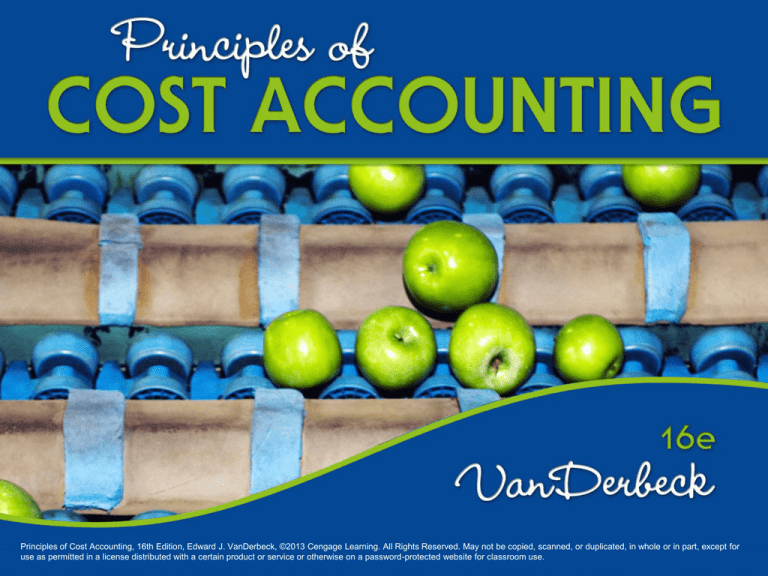
Principles of Cost Accounting, 16th Edition, Edward J. VanDerbeck, ©2013 Cengage Learning. All Rights Reserved. May not be copied, scanned, or duplicated, in whole or in part, except for
use as permitted in a license distributed with a certain product or service or otherwise on a password-protected website for classroom use.
Chapter 2
Accounting for Materials
Learning Objectives
Recognize the two basic aspects of
materials control.
Specify internal control for materials.
Account for materials and relate materials
accounting to the general ledger.
Account for inventories in a just-in-time
(lean production) system.
Learning Objectives (cont.)
Account for scrap materials, spoiled goods,
and defective work.
A cost control System
• The major function of a cost control
system is to keep expenditures within the
limits of a preconceived plan.
• An effective cost control system is
designed to control the actions of people
responsible for expenditures because
people control costs. Costs do not control
themselves.
A cost control system
• An effective cost control system should
include the following:
1. A specific assignment of duties and
responsibilities.
2. A list of individuals who are authorized to
approve expenditures.
3. An established plan of objectives and
goals.
A cost control system
4. Regular reports showing the differences
between goals and actual performance.
5. A plan of corrective action designed to
prevent unfavorable variances from
recurring.
6. Follow-up procedures for corrective
measures.
Materials Control
• The two basic aspects of materials control
are :
(1) the physical control or safeguarding of
materials
(2) control over investments in materials
Physical Control of Materials
• Limited Access – only authorized
personnel should have access to material
storage areas.
• Segregation of duties- segregation of
employee duties to minimize opportunities
for misappropriation of assets.
• Accuracy in recording – accurate
recording of the purchase and issuance of
materials.
Investment Control of
Materials
• Maintaining the appropriate level of raw
materials is one of the most important
objectives of materials control.
• An inventory of sufficient size and variety
for efficient operations must be
maintained.
• Management should consider other
working capital needs in determining
inventory levels.
Investment Control of
Materials
• Adequate planning and control is required.
• Management must determine:
1. When orders must be placed
2. How many units should be ordered
• Order point must be determined; order point
is a minimum level of inventory that should
be determined for each type of raw material,
and inventory records should indicate how
much of each type is on hand.
Investment Control of
Materials
• Order point is based on the following data:
1. Usage – the anticipated rate at which the
material will be used.
2. Lead time – the estimated time interval
between the placement of the order an the
receipt of the material.
3. Safety Stock - estimated minimum level of
inventory needed to protect against
stockouts
Economic Order Quantity
(EOQ
• The optimal quantity to order at one time.
• Minimizes the total order and carry costs
over a period of time.
Calculating EOQ
• EOQ = Economic
•
•
•
Order Quantity
C = Cost of placing
an order
N = Number of units
required annually
K = Annual carrying
cost per unit of
inventory
EOQ =
2CN
K
Materials Control Procedures
• Materials control procedures generally
related to the following functions:
1. Purchase an receipt of materials
2. Storage of materials
3. Requisition and consumption of materials
Materials Control Personnel
• Personnel involved in materials control
usually include
1. Purchasing Agent
2. Receiving Clerk
3. Storeroom Keeper
4. Production Department Supervisor
Control During Procurement
• Documents commonly used in procuring
materials include:
1. Purchase requisitions
2. Purchase Orders
3. Vendor’s invoices
4. Receiving reports
5. Debit-credit memoranda
Control During Procurement
Control During Storage and
Issuance
• Materials Requisition
• Returned Materials Report
Accounting for Materials
• A company’s inventory records should
show (1) the quantity of each kind of
material on hand and (2) its cost.
• The materials accounting system must be
integrated with the general ledger.
• Purchases of materials on account are
recorded as a debit to Materials in the
general ledger.
Accounting for Materials
• Materials account is a control account that
is supported by a materials ledger.
Flow of materials and costs
• Flow of materials is the order in which
materials are actually issued for use in the
factory.
• Flow of costs is the order in which unit
costs are assigned to materials issued.
Cost Flow Methods
• First-In, First Out (FIFO) Method – the
materials issued are assumed to be taken
from the oldest materials in stock.
• Last-In, First Out (LIFO) Method – the
materials issued are assumed to be taken
from the most recent purchase prices.
• Moving Average Method – assumes that the
materials issued at any time are simply
withdrawn for a mixed group of materials.
Interrelationship of Materials
Documents and Accounts
Just-in-Time Materials Control
• In a just-in-time inventory system (lean
production system), materials are
delivered to the factory immediately prior
to their use in production.
Just in Time Materials Control
Just in time and Cost Control
• Throughput time – the time it takes a unit
to make it through the manufacturing
system.
• Velocity – speed at which units are
produced in the system.
• Nonvalue-added activities – operations
that add costs but do not add value to the
product for its customers, such as moving,
storing, and inspecting the inventories.
Just in Time and Cost Flows
Scrap, Spoiled Goods, and
Defective Work
• Scrap materials may result naturally from
the production process.
• Spoiled units have imperfections that
cannot be economically corrected. The
loss can be treated as part of the job or
charged to factory overhead.
• Defective work has imperfections that are
correctable. The extra costs are either
charged to the job or factory overhead.
Accounting for Scrap
Materials
• If the scrap value is small:
Cash……..XXX
Scrap Revenue XXX
• If the scrap value is relatively high:
Scrap Materials XXX
Scrap Revenue
Cash XXX
Scrap Materials XXX

